Results for

The 2025 scorecard: Bitcoin, Gold and Silver’s biggest calls
Every cycle breeds prophets. From early alarms to stubborn denials, 2025 wasn’t short on conviction regarding the market's direction.
Every market cycle produces its prophets.
Some sound the alarm early. Some ride the wave all the way up. Others dig their heels in, convinced the market is wrong-right until it proves them so.
Looking back, 2025 wasn’t short on conviction. Bitcoin tore through psychological ceilings. Gold rewrote the record books. Silver finally stopped playing second fiddle. And all along the way, analysts, economists, fund managers and Twitter sages were staking their reputations on what came next.
This is not a victory lap - nor a pile-on. It’s a clear-eyed look at the voices that shaped the narrative, the calls that aged well, and the ones that struggled as reality unfolded.
Bitcoin: the great divide widened
Eugene Fama - intellectually consistent, market-defiant
If Bitcoin had a chief sceptic-in-residence this year, it was Eugene Fama.
Long before Bitcoin climbed into the trillion-dollar club, the Nobel Prize-winning economist had already delivered his verdict. In conversations earlier in the cycle, Fama argued that Bitcoin violated the basic rules of money, no stable value, no intrinsic anchor, no reason to survive in the long run.
He went further than most, assigning Bitcoin a “close to 100% probability” of becoming worthless within a decade.
From a 2025 vantage point, the market didn’t just disagree - it steamrolled past him.
Bitcoin surged beyond $100,000, institutional adoption accelerated, spot ETFs rewired access, and regulators - once seen as existential threats - began laying out red carpets instead of roadblocks.
And yet, Fama wasn’t really “wrong” in the way markets usually mean it.
His critique wasn’t about price - it was about the definition of money itself. If Bitcoin survives, he argued, then monetary theory must change with it. In that sense, 2025 didn’t disprove Fama. It simply postponed the reckoning he believes is inevitable.
The market voted with capital. The theory remains unresolved.
Tom Lee - momentum, timing, and conviction rewarded
If Fama represented academic resistance, Tom Lee embodied market instinct.
Lee had already earned credibility by calling the S&P 500 rebound almost to the point. When he turned that confidence toward Bitcoin - projecting $100,000 as a base case - many dismissed it as ETF hype.
They shouldn’t have.
By August 2025, Bitcoin not only cleared that level, it held it. Lee’s thesis was brutally simple and, in hindsight, brutally effective:
- ETFs opened the floodgates
- Supply tightened after the halving
- Rates eased, and risk appetite followed
Lee even warned that volatility would shake out weak hands - flagging the possibility of sharp pullbacks before any sustained run higher. That nuance mattered. Bitcoin did wobble. Conviction was rewarded. Hesitation was punished.
In a year full of bold forecasts, Lee’s stood out because the market behaved exactly as his framework suggested.
Jon Glover and the technicians - right on timing, early on finality
Then there were the technicians.
Ledn’s Jon Glover, leaning on Elliott Wave theory, called Bitcoin’s surge toward $125,000 with impressive precision - just as sentiment elsewhere began to wobble. That call aged well.
Where it became contentious was the follow-through.
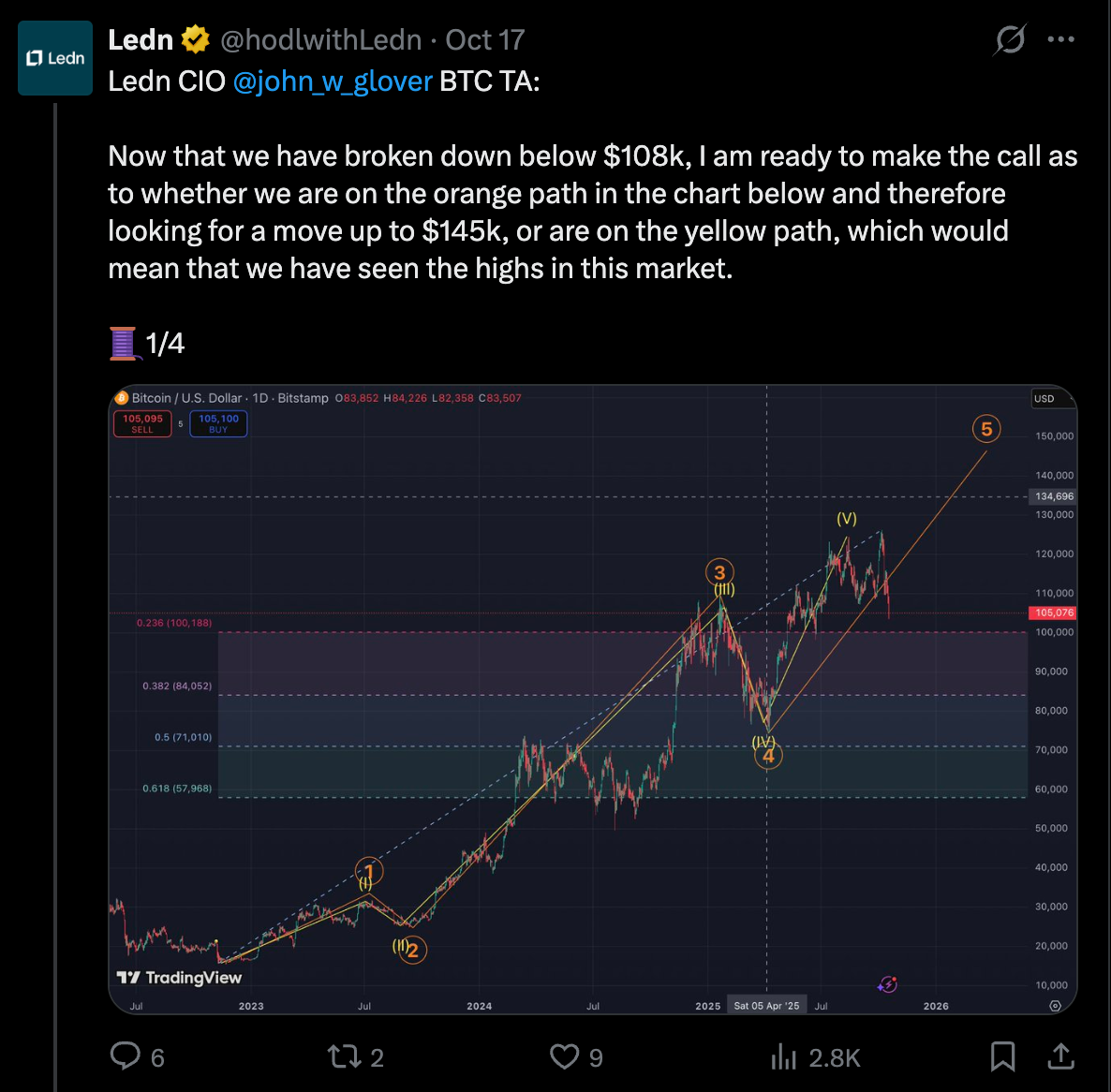
Declaring the bull market “over” after the pullback felt decisive - perhaps too decisive.
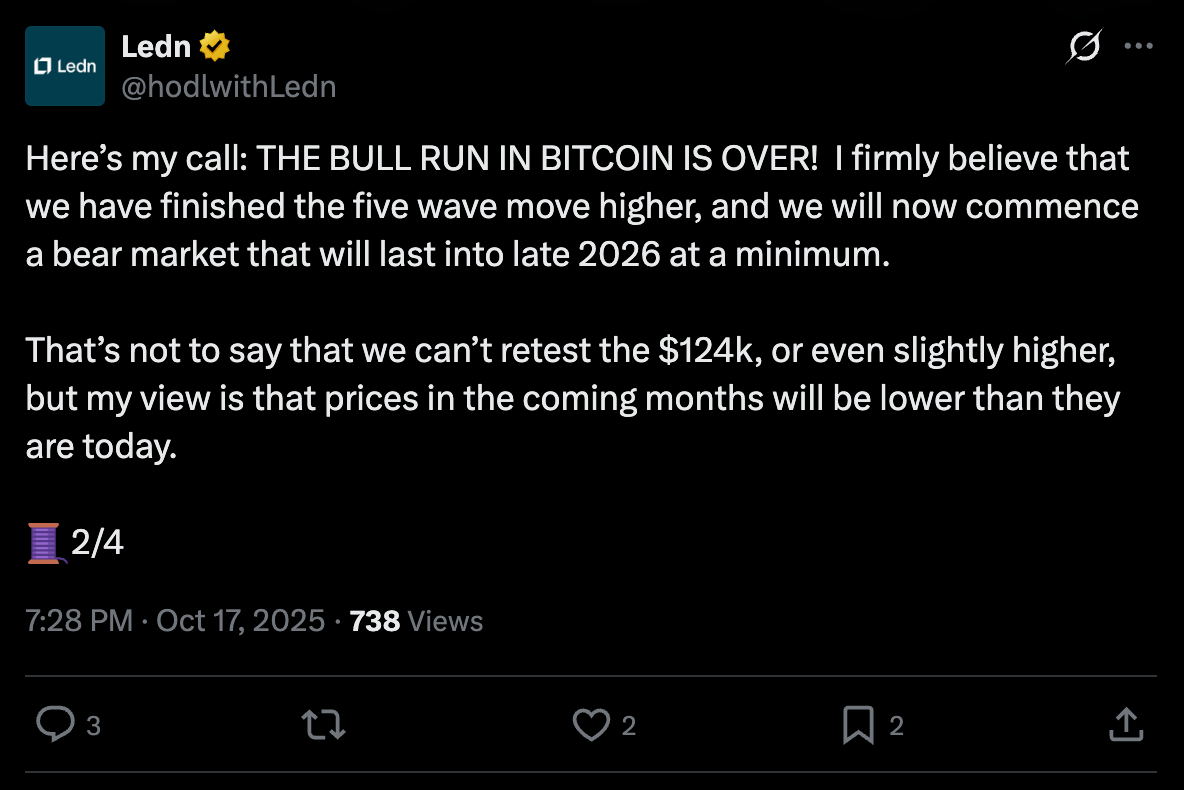
Yes, Bitcoin corrected. Yes, volatility returned. But broader adoption trends, ETF inflows and regulatory tailwinds refused to collapse alongside price.
2025 reminded traders of an old lesson: cycles bend, but narratives don’t always break.
Gold: the quiet winner that stopped whispering
Gold entered 2025 already strong. It ended the year with undeniable.
Voices like Maria Smirnova and Rick Rule had been arguing for years that gold’s rise wasn’t speculative - it was structural. Central banks weren’t buying headlines; they were buying insurance. Eastern demand wasn’t fleeting; it was a cultural phenomenon. And fiat erosion wasn’t theoretical - it was lived.
When gold pushed beyond $3,000 and continued to rise, the disbelief faded.
Critically, analysts who framed gold purely as a crisis hedge missed the broader shift. This wasn’t panic buying. It was balance-sheet management - from sovereigns to households.
Rick Rule’s blunt arithmetic landed hardest in hindsight: when inflation quietly outpaces yields, owning nothing but paper becomes a guaranteed loss. Gold didn’t need to “replace” the dollar. It simply needed to reclaim its historical share of global portfolios.
That reversion began in earnest this year.
The miners lagged, and then they didn’t
Sceptics mocked gold equities early on. Why weren’t miners exploding if gold was at record highs?
The answer, as Rule pointed out at the time, was simple: central banks buy bullion, not mining shares.
But as margins stabilised, discipline improved, and free cash flow surged, the disconnect began to close. By the second half of the year, the re-rating was underway - quietly, methodically, without the mania of past cycles.
Those who waited for headlines missed the move.
Silver: from perpetual underdog to reluctant star
Silver spent years trapped in explanation mode. Industrial metal. Monetary metal. Not quite gold. Not quite copper.
In 2025, it finally stopped apologising.
Banks like Citigroup raised forecasts aggressively, calling for silver to outperform gold - and the logic held. Investment demand surged. ETF holdings climbed. Industrial consumption, driven by solar and electrification, refused to slow.
The gold-to-silver ratio compressed sharply, just as analysts had suggested it would once capital rotated downstream.
Veterans like Smirnova had long argued that silver bull markets don’t announce themselves - they accelerate. That pattern re-emerged. Slowly at first. Then suddenly.
Those still waiting for a perfect supply narrative missed the point. Silver didn’t need scarcity headlines. It needed sustained demand - and it got it.
Key takeaway
If 2025 taught markets anything, it was this:
- Price doesn’t wait for consensus
- Narratives age faster than capital flows
- Being early is only useful if you stay solvent long enough to be right
Some voices were vindicated by price. Others by principle. A few by sheer timing.
And perhaps the real lesson of the year wasn’t about who was right or wrong - but about how markets reward conviction only when it’s paired with adaptability.
As Bitcoin, gold and silver roll into the next chapter, one thing is certain:
- The next year-ender will have just as many confident voices.
- The market will decide - again - which ones it listens to.
%20(1)%20(1)%20(1)%20(1)%20(1).png)
Meta stock slips despite strong rally as AI spending fears resurface
Meta softens at year-end despite a 75% YTD rally. A minor pullback, yet it highlights deeper tensions facing Big Tech.
Meta Platforms entered the final trading days of the year on a softer footing, despite a standout rally that has lifted the stock by more than 75% year to date. Data showed shares slipped modestly on Monday, closing near $660, as thin holiday volumes amplified routine year-end profit-taking and insider sales, which briefly unsettled sentiment.
The pullback may look minor on the surface, but it highlights a deeper tension facing Big Tech. Investors are weighing Meta’s expanding artificial intelligence ambitions against memories of past capital-spending missteps. With only a handful of sessions left before 2026, that debate is beginning to shape near-term price action.
What’s driving Meta’s latest pullback?
The immediate pressure on Meta shares reportedly came from seasonal dynamics rather than any shift in fundamentals. After rallying sharply through most of 2025, the stock entered the final week of the year near levels that naturally invite profit-taking. According to analysts, light holiday trading tends to exaggerate these moves, particularly in mega-cap stocks that dominate index weightings.
That backdrop coincided with Meta’s December dividend cycle and a pair of small insider sales. Two executives sold a combined total of just over 1,000 shares on 15 December at roughly $646 per share, transactions worth less than $1 million and pre-scheduled under Rule 10b5-1 trading plans. While immaterial in size, the timing fed a short-term narrative of position trimming that traders were quick to price in during a quiet session.
Why it matters
Short-term selling alone would not normally merit attention. According to reports, what makes this move more meaningful is the sensitivity investors still show toward Meta’s spending discipline. In October, the company warned that expenses in 2026 would grow “significantly faster” than in 2025, driven by AI infrastructure and cloud investment expected to exceed $40 billion.
That language revived uncomfortable comparisons to 2021 and 2022, when heavy metaverse spending erased more than $300 billion in market value as investors lost patience. Jason Helfstein, an analyst at Oppenheimer, has cautioned that markets remain “quick to punish” Meta if capital intensity starts to outpace visible returns. Even modest pullbacks now reflect that lingering scepticism.
Impact on the tech market
Meta’s dip did not occur in isolation. The broader technology complex also cooled as the Nasdaq and S&P 500 retreated from record highs, with investors locking in gains across heavyweight growth stocks. Nvidia and Tesla, fellow members of the so-called “Magnificent Seven,” also finished lower, reinforcing the sense of coordinated year-end de-risking.
Market experts noted that because Meta carries substantial index weight, its movements increasingly act as a barometer for risk appetite in mega-cap tech. When the stock softens without company-specific news, it often signals broader concerns about valuations, rates, or the sustainability of AI-driven earnings expectations. In that context, Monday’s decline looked less like a verdict on Meta and more like a pause across the sector.
Meta’s AI ambitions add a new layer of scrutiny
Investor caution has been sharpened by Meta’s accelerating push into advanced AI. The company recently confirmed its acquisition of Manus, a Singapore-based autonomous AI agent startup that reportedly reached $100 million in annual recurring revenue within eight months of launch. Manus’s technology will be integrated across Meta’s consumer and business products, including Meta AI.
Strategically, the deal strengthens Meta’s position in general-purpose AI agents, an area seen as the next phase of monetisation beyond chat interfaces. Financially, however, it reinforces the perception that Meta is entering another heavy-investment cycle. Combined with the launch of Meta Superintelligence Labs and aggressive infrastructure build-outs, investors are watching closely to see whether returns materialise faster than they did during the metaverse era.
Expert outlook
In the near term, traders are focused less on headlines and more on technical levels. A sustained move below the mid-$650 range could test late-December support, while a recovery above $660 would suggest the selling pressure was largely seasonal. Volume remains the key signal, as thin liquidity can distort price discovery.
Looking ahead to early February, when Meta is expected to report earnings based on historical patterns, attention will likely shift back to guidance rather than revenue alone. Investors want clarity on how quickly AI investment can translate into advertising growth and margin stability. Until then, Meta shares are likely to trade as a proxy for confidence in Big Tech’s AI spending cycle.
Key takeaway
Meta’s late-year dip says more about investor positioning than company performance. Following a powerful rally, traders are cautious as AI spending intensifies and liquidity thins. The stock remains caught between confidence in long-term AI monetisation and sensitivity to capital-intensity risks. The next earnings update will be the decisive moment to see which narrative prevails.
Meta technical insights
Meta is consolidating after a sharp pullback, with price trading around the Bollinger mid-band, signalling a pause in momentum rather than a renewed trend. The upside remains capped below the $673 resistance level, where rallies have repeatedly drawn profit-taking.
On the downside, $640 is the first key support, followed by $585 if selling pressure resumes. A sustained move back below the mid-band would tilt the bias lower. Momentum remains neutral, with the RSI almost flat just above the midline, highlighting a lack of strong conviction from either buyers or sellers.

.png)
Silver overtakes Nvidia as volatility grips a historic rally
Silver surged 185% YTD to $84/oz, hitting a $4.65T market cap and flipping Nvidia as the world’s 2nd largest asset.
Silver has rarely moved quietly, but its latest surge has redrawn the market landscape. The metal has risen more than 185% year-to-date, briefly trading above $84 an ounce and pushing its estimated market value to $4.65 trillion, overtaking Nvidia to become the world’s second-largest asset by valuation. The move marks silver’s strongest annual performance since 1979, a year etched into market history for inflation shocks and commodity turmoil.
What followed was a reminder of silver’s reputation. Within little more than an hour of futures reopening, prices swung violently, shedding nearly 10% before stabilising near $75. That whipsaw now sits at the centre of a larger question: is silver entering a structurally supported bull market, or replaying a familiar cycle where leverage and volatility eventually overwhelm fundamentals?
What’s driving Silver’s historic surge?
Silver’s breakout reflects more than speculative enthusiasm. Expectations that the US Federal Reserve will deliver deeper rate cuts in 2026 have revived demand for hard assets, though the CME FedWatch tool shows an 82.8% probability of rates remaining unchanged at the next January meeting.
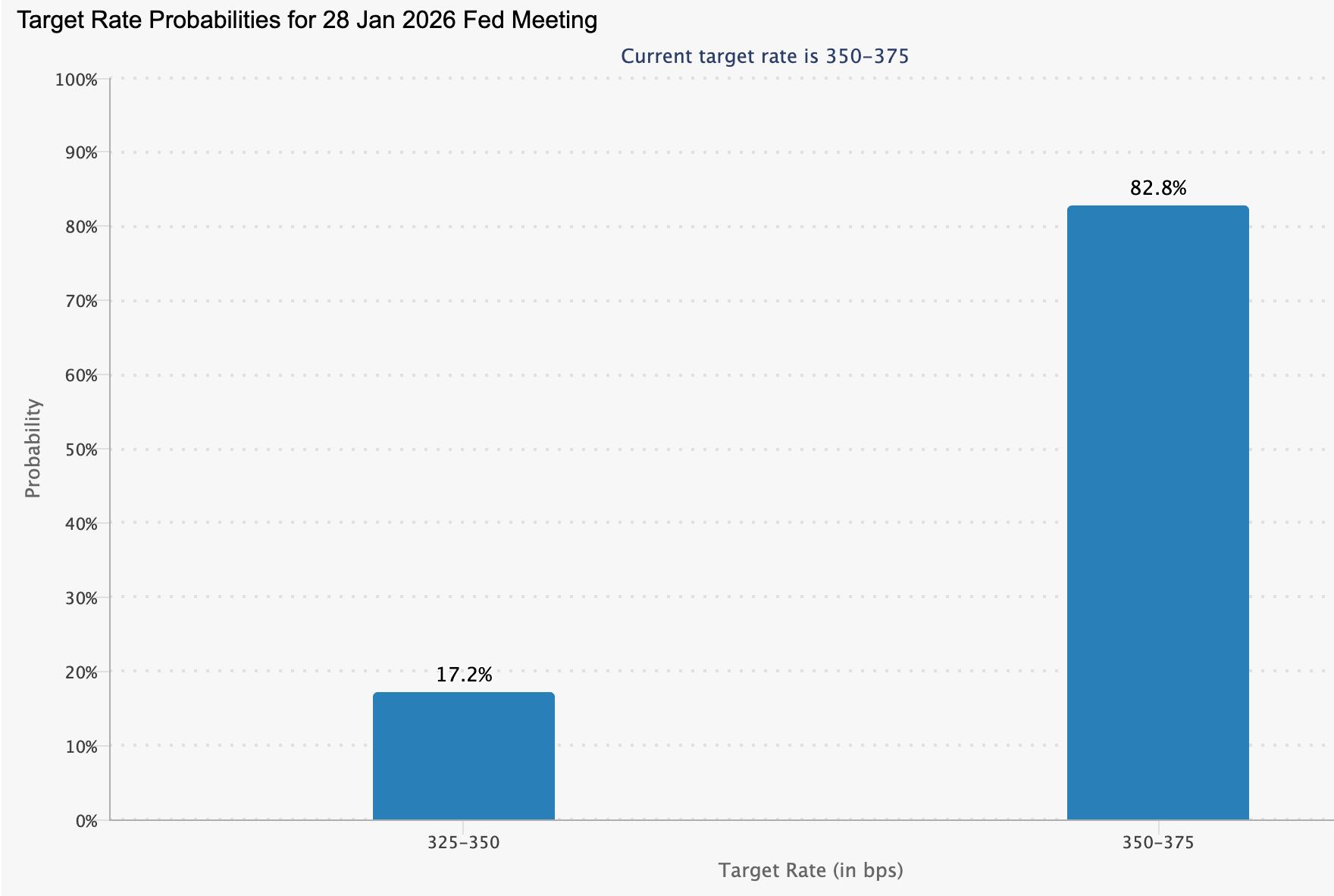
Lower real yields have historically supported precious metals, but silver has amplified this trend, benefiting from its dual role as both a monetary hedge and an industrial input.
Beneath that macro backdrop lies a supply imbalance that has been building for years. 2025 is projected to be the fifth consecutive year in which global silver demand exceeds supply, shifting the market from cyclical tightness into structural deficit.
Industry estimates place global demand at nearly 1.12 billion ounces this year, against a supply of roughly 1.03 billion ounces, resulting in an annual shortfall of approximately 95 million ounces. Since 2021, cumulative deficits are estimated to be around 800 million ounces, equivalent to nearly an entire year of global mine production. That gap has been bridged by drawing down inventories across major hubs, steadily eroding the market’s shock absorber.
The supply side has struggled to respond despite rising prices. Mine production in 2025 is estimated to be approximately 813 million ounces, remaining broadly flat year-over-year.
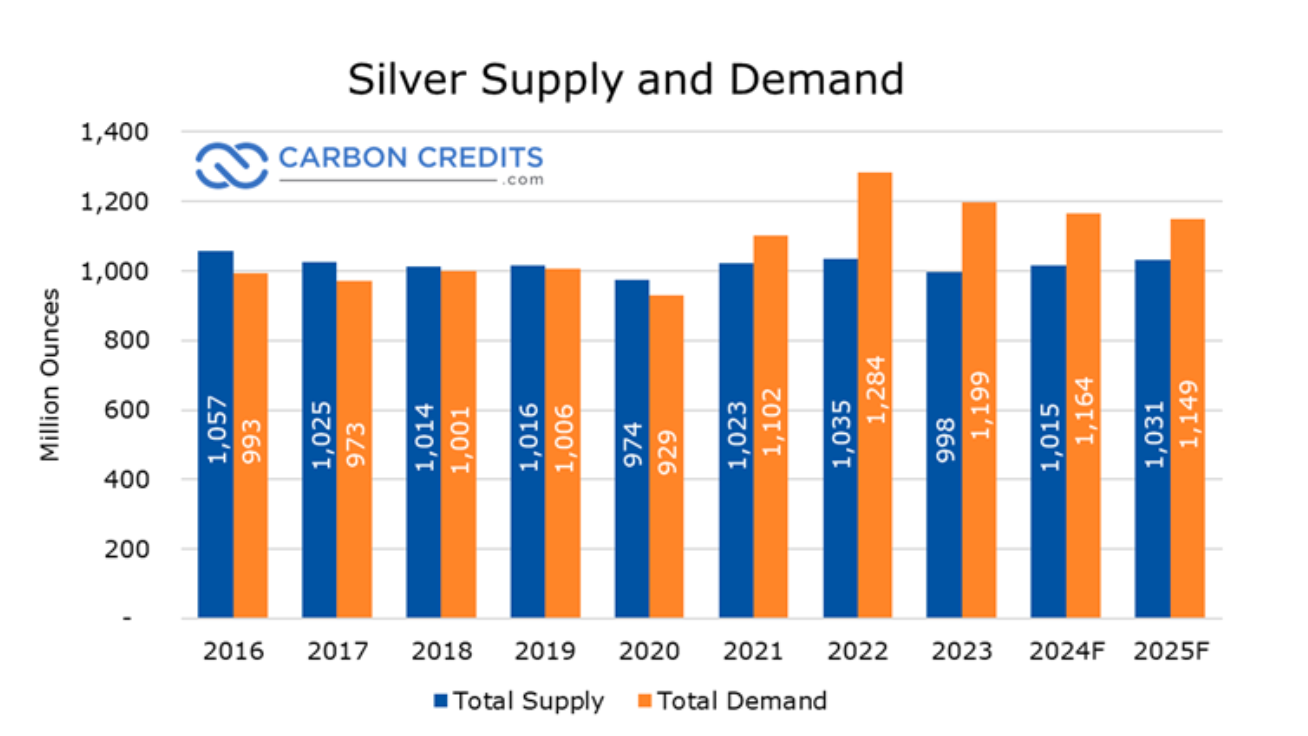
Roughly two-thirds of global silver output is produced as a byproduct of mining for metals such as copper, zinc, and lead, limiting how quickly the supply can react to silver-specific price signals. Recycling offers only marginal relief, with secondary supply rising by around 1%, far short of what would be needed to close the deficit. In practice, tightening demand is transmitted through inventories and futures markets, instead of amplifying volatility when positioning shifts.
Policy risk has added further strain. Beijing confirmed that, as of 1 January 2026, silver exporters will be required to obtain government licences, restricting overseas sales to large, state-approved producers. With China controlling an estimated 60–70% of global refined silver capacity, even modest export constraints carry outsized implications for physical availability. That risk premium has helped drive prices sharply higher, while also making the market more sensitive to sudden changes in sentiment.
Why it matters
Silver’s rally carries implications well beyond commodity trading desks. Unlike gold, silver is deeply embedded in modern industry, from electrification and solar panels to electric vehicles and data centres. That dual identity explains why the surge has drawn warnings from industrial leaders. Tesla CEO Elon Musk described rising silver prices as “not good,” citing the metal’s importance across a wide range of manufacturing processes.
Analysts remain divided on whether the move is sustainable. Tony Sycamore, a market analyst at IG, warned that a potential “generational bubble” may be forming as capital flows into precious metals collide with genuine supply stress. In his view, the scramble for physical silver has become self-reinforcing, pulling prices away from levels justified by near-term industrial demand.
That tension matters because silver’s price sits at the intersection of financial speculation and real-world production costs. Extreme moves risk distorting both sides of the market.
Impact on industry and markets
For the industry, sustained high prices carry consequences. Solar manufacturing now accounts for a significant share of annual silver consumption, while electric vehicles require materially more silver than internal combustion engines. Analysts estimate that prices approaching $130 per ounce would erode operating margins across the solar sector, potentially slowing adoption at a time when global renewable targets are accelerating.
Financial markets face a different stress point. The Chicago Mercantile Exchange has announced its second silver margin hike in two weeks, raising initial margin requirements on March 2026 contracts to approximately $25,000. The move increases pressure on leveraged traders as volatility surges.
History looms in the background. In 2011, a series of rapid margin hikes coincided with silver’s peak near $50, triggering forced deleveraging and a sharp correction. The 1980 episode was even more severe, as regulatory intervention and aggressive rate hikes crushed a highly leveraged rally. While today’s measures are less extreme, analysts warn that even moderate reductions in leverage can overwhelm physical buying in the short term.
Expert outlook
The near-term outlook hinges on whether physical demand can absorb the forced selling of futures. COMEX inventories have reportedly fallen by around 70% over the past five years, while China’s domestic silver stocks sit near decade lows. Deeply negative silver swap rates suggest buyers are increasingly demanding real delivery rather than paper exposure.
Risks remain elevated. Hedge funds face year-end rebalancing, commodity index adjustments loom, and geopolitical headlines remain fluid. A sustained break below $75 could signal a deeper consolidation phase, while renewed stress in physical markets may quickly revive upside momentum.
For now, silver stands at a crossroads where structural scarcity collides with financial leverage. The coming sessions are likely to determine whether this historic rally matures into a longer-term re-pricing, or fractures under the weight of its own volatility.
Key takeaway
Silver’s surge past Nvidia suggests more than speculative excess. A multi-year structural supply deficit, combined with tightening inventories and rising industrial demand, has collided with leverage-heavy markets. Margin hikes and geopolitical shifts may drive sharp corrections, but the underlying scarcity story appears unresolved. Investors may wish to closely monitor physical inventories, China’s policy signals, and futures market positioning as silver enters its most critical phase.
Silver technical outlook
Silver has seen a sharp pullback after aggressively riding the upper Bollinger Band, signalling that upside momentum has become overstretched. Price remains elevated, but the recent rejection suggests short-term profit-taking after an extended rally.
On the downside, $57.00 is the first key support, followed by $50.00 and $46.93. A sustained move back towards the Bollinger mid-band would increase the risk of a deeper corrective phase. Momentum is cooling, with the RSI dropping sharply from overbought territory, reinforcing the case for consolidation rather than immediate trend continuation.
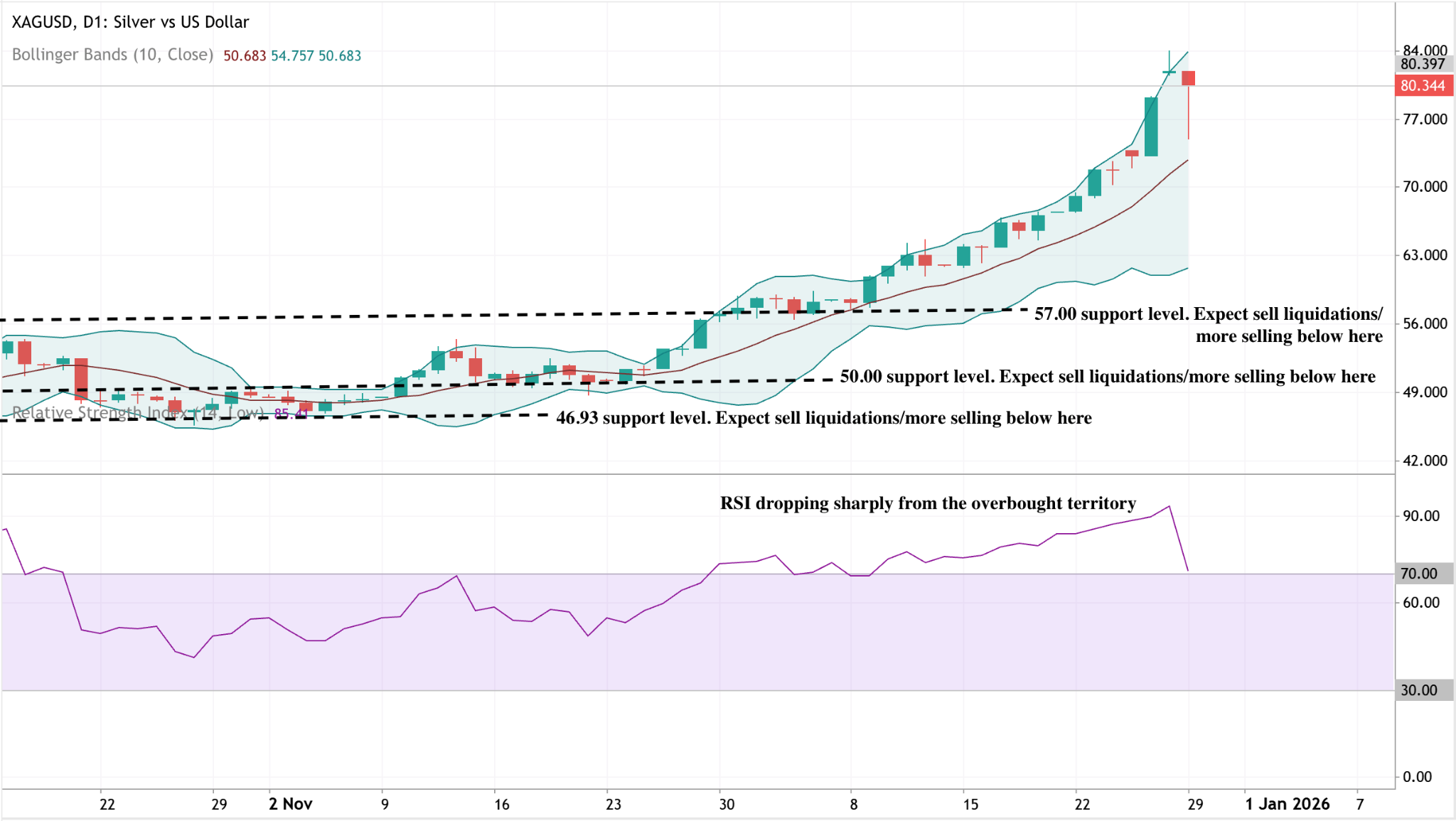
%20(1)%20(1).png)
Precious metals are on fire but this rally isn’t what it seems
Precious metals are surging, but data suggests this historic rally isn't driven solely by panic or a single macroeconomic trigger.
Precious metals are on fire, but not for the reasons markets usually assume. Data shows that Gold breaking above $4,500 an ounce, silver rising nearly 150% this year, and platinum posting one of the sharpest rallies in decades might resemble a textbook flight to safety. Yet, this surge is not being driven solely by panic, nor by a single macroeconomic trigger.
Instead, the metals complex is reacting to deeper fractures forming beneath the global economy. Monetary policy credibility is weakening, supply chains are tightening in unexpected places, and industrial demand is reshaping how scarcity is priced. Each metal is responding to a different pressure point, and together they are signalling something more structural than a short-lived risk-off move.
What’s driving the precious metals rally?
At the surface level, monetary policy has provided the spark. The US Federal Reserve has cut 75 basis points this year, with markets increasingly convinced that further easing will follow in 2026.
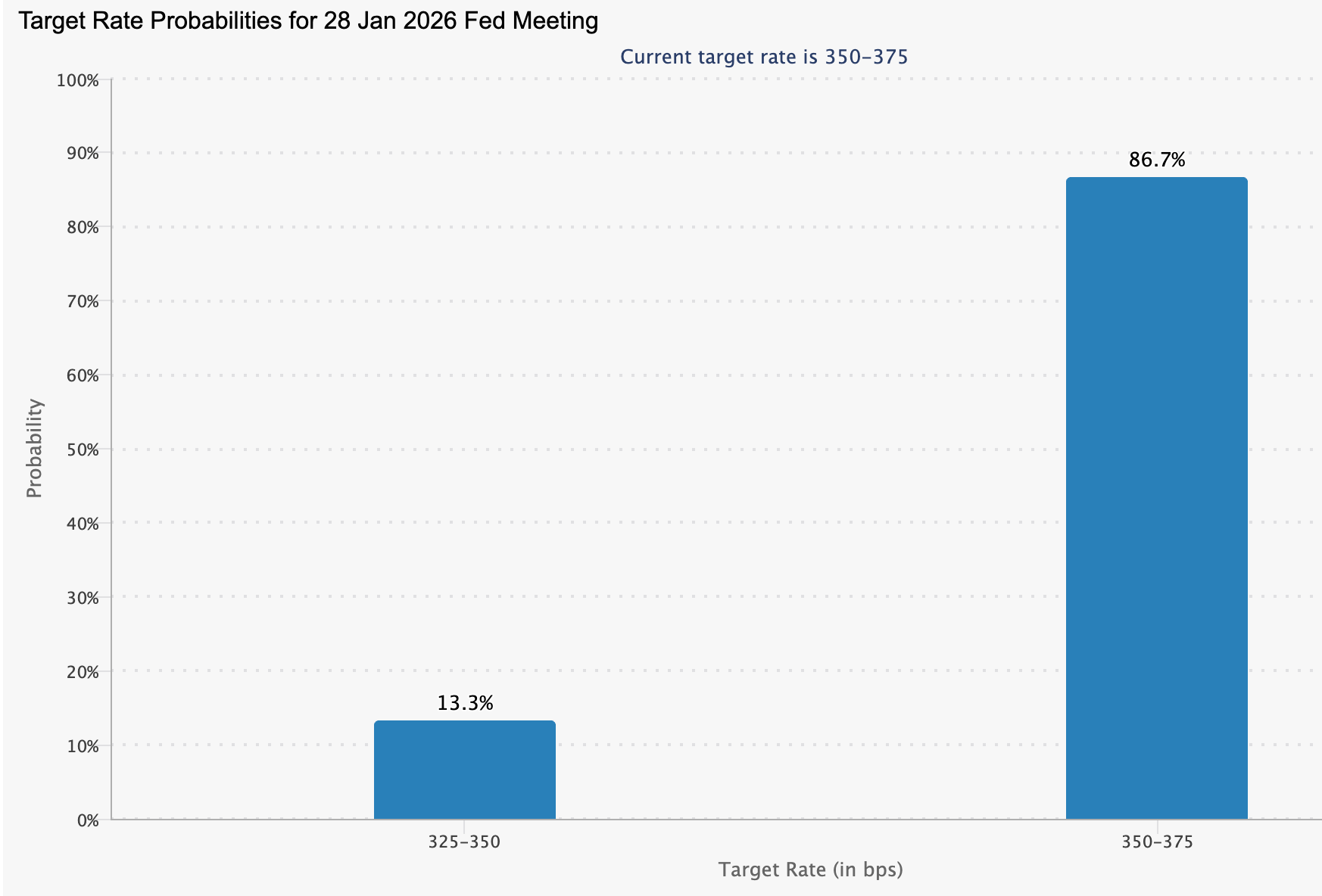
Lower real yields have weakened the US dollar, which recently fell to a near three-month low, making dollar-priced metals more attractive to global buyers.
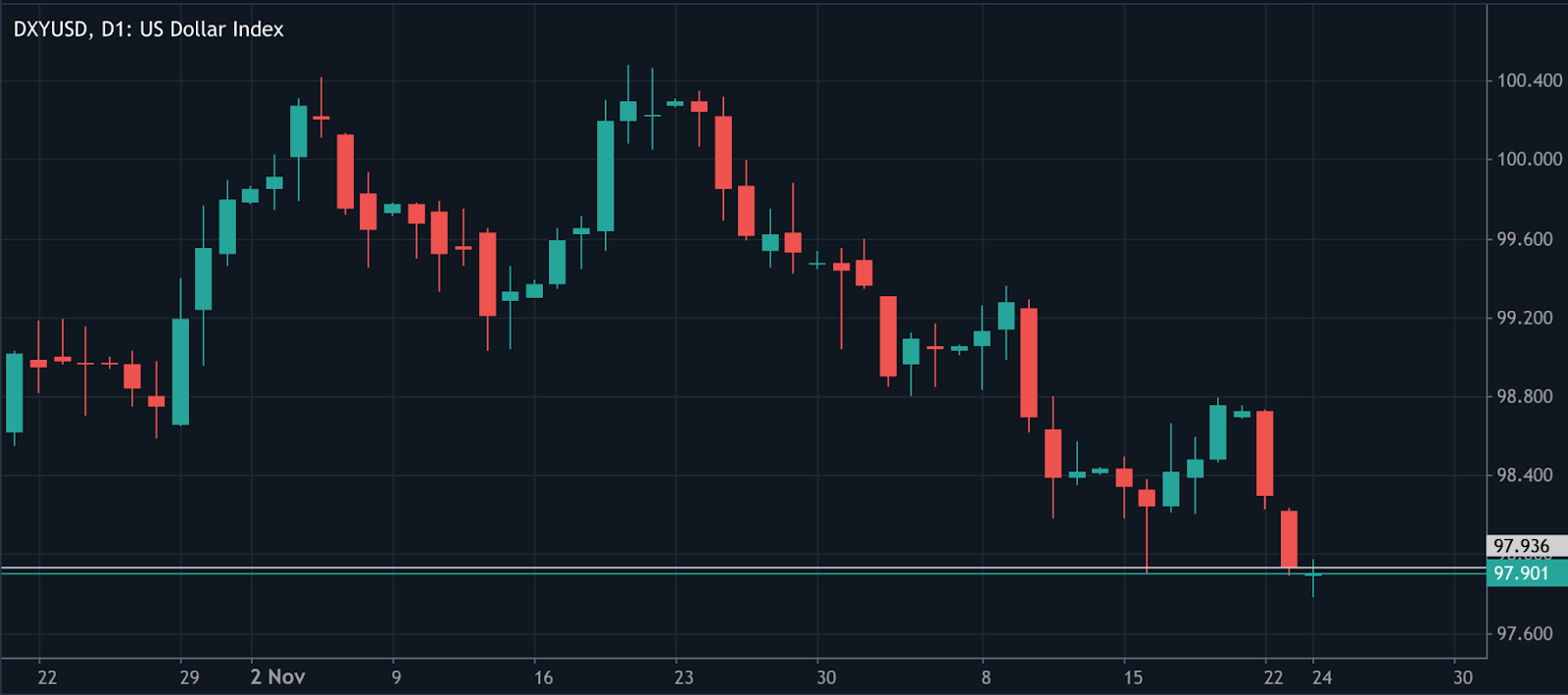
But rate cuts alone do not explain why silver and platinum are outperforming gold so dramatically. The difference this time lies in physical constraints. Silver has surged through the $70-per-ounce level amid persistent supply deficits and robust industrial demand from the solar energy, electronics, and electric vehicle sectors. Its inclusion on the US critical minerals list has reinforced the idea that silver shortages are structural rather than cyclical.
Platinum’s rally goes further still. The market is experiencing its third consecutive annual deficit, with shortfalls estimated at approximately 692,000 ounces, or nearly 9% of global demand. Above-ground inventories have fallen to about five months of consumption, the lowest since 2020. This is not speculative scarcity - it is measurable, physical tightness.
Why it matters
This rally is significant because it marks a shift in the valuation of precious metals. Analysts note that Gold remains a monetary hedge, reflecting concerns about central-bank independence, inflation credibility, and geopolitical stability. Ongoing tensions involving Venezuela, Russia, and global trade policy have reinforced its role as strategic insurance rather than a tactical trade.
Silver and platinum, however, are increasingly being priced as strategic resources. William Rhind, CEO of GraniteShares, argues that platinum is now viewed “as both a precious metal and a strategic industrial asset”, a distinction that fundamentally alters its valuation framework. When metals are treated as inputs critical to energy transition, manufacturing, and emissions control, price sensitivity changes and volatility increase.
This shift also explains why pullbacks have been shallow. Investors are not merely chasing momentum; they are responding to tightening supply visibility and policy-driven demand that cannot be quickly substituted.
Impact on markets, industry, and investors
Platinum’s resurgence highlights how assumptions about electrification have been challenged. Expectations that electric vehicles would rapidly erode platinum demand have proven premature.
Slower-than-expected EV adoption, combined with stricter emissions standards, has increased platinum loadings in catalytic converters rather than reduced them. Engineers have found that higher platinum content improves durability and performance, especially in heavy-duty and high-temperature environments.
Industrial demand is also broadening. Platinum plays a critical role in hydrogen fuel cells, chemical refining, and industrial decarbonisation. China’s approval of platinum and palladium futures contracts has reshaped global price discovery, with trading volumes on the Guangzhou Futures Exchange now influencing established Western benchmarks.
For investors, this creates an unusual environment. Gold offers stability but limited upside in terms of scarcity, while silver and platinum carry higher volatility tied to industrial cycles and policy decisions. The rally is not uniform, and treating precious metals as a single asset class risks missing the underlying divergence.
Expert outlook
Looking ahead, analysts expect continued support for metals but warn that the drivers are becoming increasingly complex. Zafer Ergezen, a futures and commodities specialist, points to the gold-to-silver ratio falling below 65 as evidence that markets are pricing aggressive rate cuts and stronger industrial demand simultaneously.
Gold’s outlook remains constructive, with Goldman Sachs forecasting a $4,900 base case for 2026, though gains may slow if inflation stabilises. Platinum’s trajectory is more sensitive to supply disruptions in South Africa and shifts in Chinese industrial demand. With production largely price-inelastic, even modest demand surprises could trigger further dislocations. The key risk is no longer oversupply, but rather the limited slack the system has left.
Key takeaway
The precious metals rally of 2025 is not a single story of fear or speculation. Gold reflects monetary unease, silver highlights industrial scarcity, and platinum exposes how fragile concentrated supply has become. Together, they point to a repricing of real-world constraints rather than a temporary risk-off trade. What happens next will depend on rates, inventories, and geopolitics - not sentiment alone.
Platinum technical insights
Platinum has surged into price discovery, with price riding the upper Bollinger Band, signalling aggressive upside momentum and strong breakout conditions. The sharp expansion of the bands highlights rising volatility, while pullbacks remain shallow, suggesting buyers are still in control.
On the downside, $1,620 is the first key support, followed by $1,525. A move back inside the Bollinger mid-band would increase the risk of a deeper correction, but for now, momentum remains firmly bullish. The RSI is rising sharply deep into overbought territory, reinforcing strength but also warning of potential short-term consolidation.
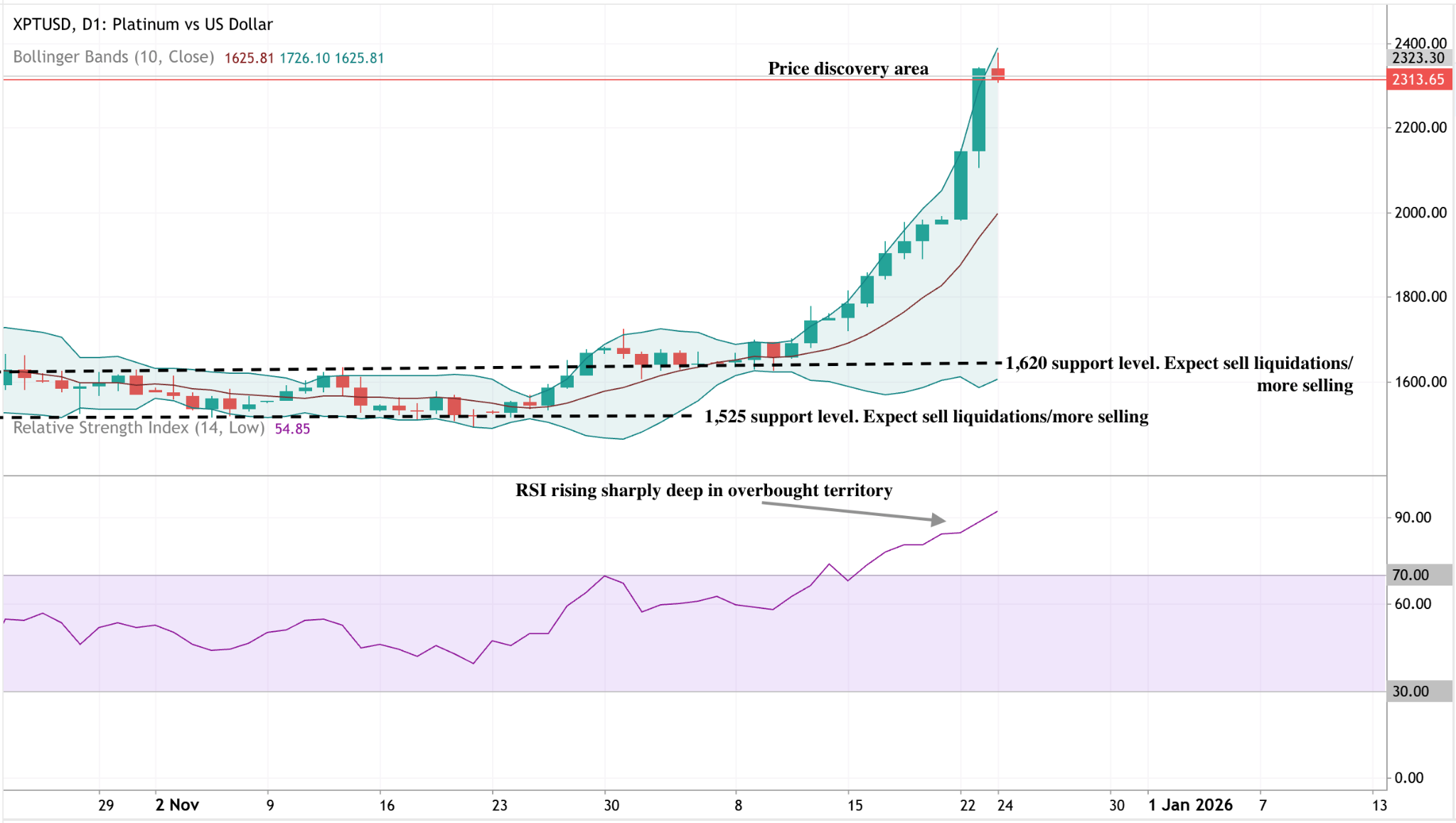
%20(1).png)
US stocks bull run is built on jobs, not hype
Global markets rally and the USD weakens, driven by confidence in US economic fundamentals and employment data.
Global markets are pushing higher, and this rally is not built on sentiment alone. From record equity highs to surging commodities and a weaker US dollar, the underlying driver remains confidence in US economic fundamentals, with employment data at the centre of market expectations.
As investors position ahead of the next US jobs report, recent market moves suggest optimism that growth can remain resilient even as financial conditions continue to evolve.
What’s driving the Fed’s hawkish cut narrative?
According to analysts, markets are increasingly pricing a scenario where the US Federal Reserve can ease policy without destabilising the economy. Strong macro data, particularly labour market resilience, has given policymakers room to balance growth support with inflation control.
Rather than expecting aggressive rate cuts, investors are leaning toward a controlled easing path. This view has helped contain interest rate volatility, even as risk assets continue to rally.
Why it matters
Reports showed that US employment data is the foundation of this bull run. A strong jobs market supports:
- Consumer spending, the backbone of US growth
- Corporate earnings, sustaining equity valuations
- Business confidence and investment
- Risk appetite across global markets
As long as hiring remains resilient, markets have justification to push higher even while inflation pressures persist in parts of the economy.
Impact on markets, businesses, and consumers
Stocks: confidence at record highs
The S&P 500 closed at a fresh record, led by growth stocks, which reflects optimism that earnings can remain durable in a stable growth environment. Investors are rewarding companies positioned to benefit from both economic resilience and technological investment.
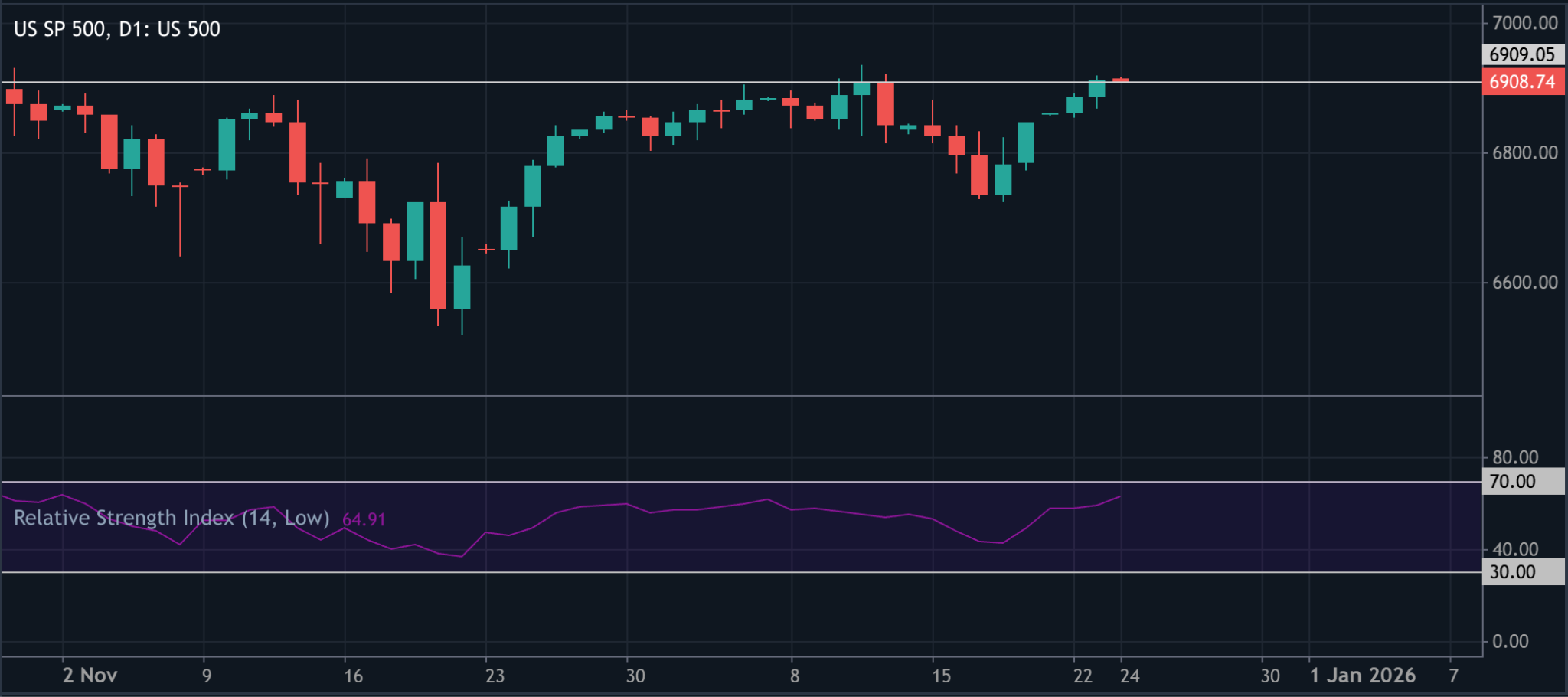
Corporates & M&A: dealmakers stay busy
A bidding war involving Warner Bros highlights how hot the M&A market has become. Dealmakers don’t work through holidays - or pursue large acquisitions - unless balance sheets are healthy and future growth looks promising.
This wave of activity reinforces the notion that corporate America remains confident about the economic outlook.
Technology: AI demand remains intact
According to reports, Nvidia’s plan to begin H200 chip shipments to China by mid-February underlines continued demand for AI infrastructure. Despite regulatory uncertainty, capital spending linked to artificial intelligence remains a powerful growth driver - and markets are treating it as such.
Currencies: the dollar loses momentum
Data revealed the US dollar’s worst drop since 2017 reflects markets looking beyond peak rates and rotating toward risk assets, commodities, and non-USD exposure. As expectations shift from restrictive policy to gradual easing, the dollar has lost its yield advantage - reinforcing risk-on behaviour elsewhere.
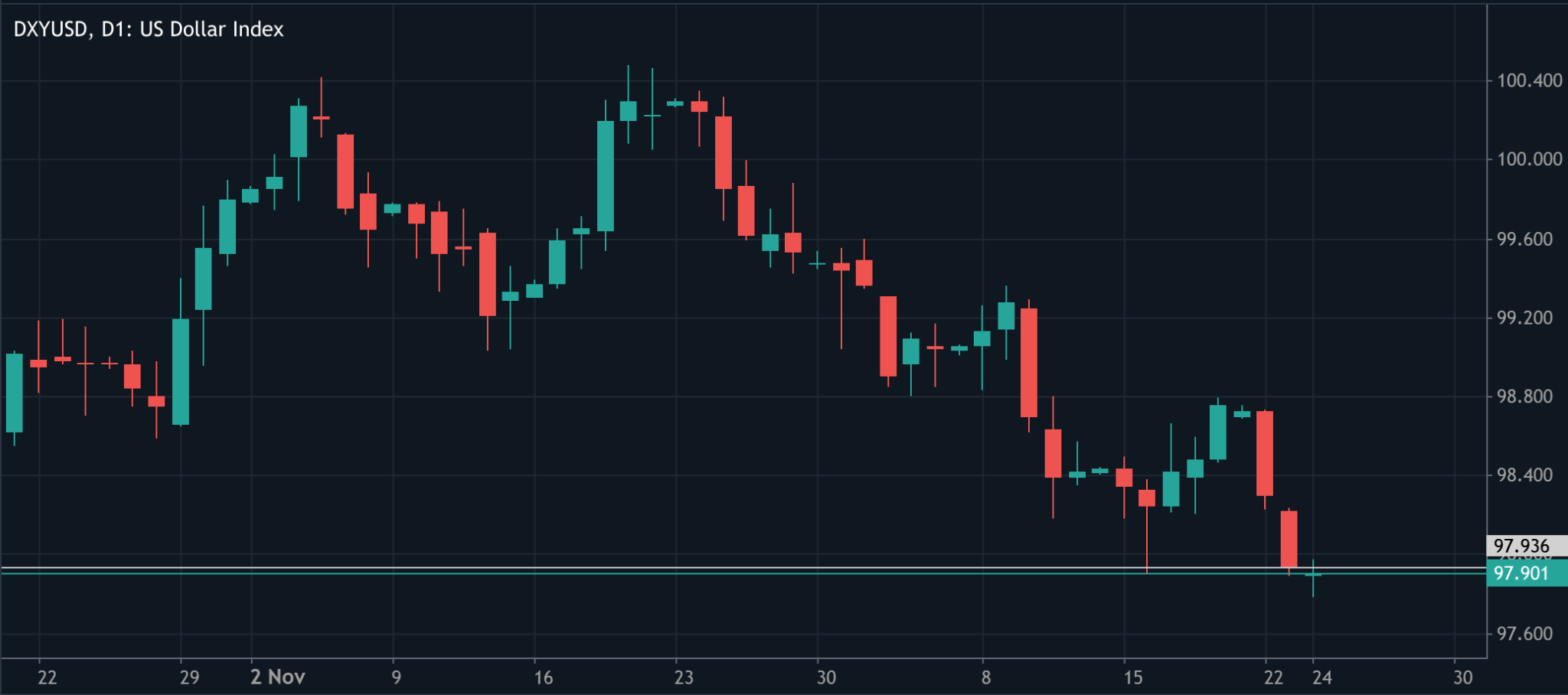
Commodities are sending a parallel signal
Commodities aren’t just rising - they’re breaking records based on data.
- Gold above $4,500/oz for the first time
- Platinum above $2,300 on tight global supplies
Market watchers noted these moves suggest that investors are positioning for a world where growth remains robust, but inflation and supply chain risks haven’t disappeared. Metals are benefiting from a weaker dollar, as well as strategic hedging and strong underlying demand.
Expert outlook: All eyes on jobs
Markets are clearly positioned for continued economic resilience, but confirmation will come from upcoming US employment data.
Analysts highlighted that a strong jobs report would reinforce confidence in the current rally. A downside surprise, however, could force markets to reassess growth expectations and risk positioning.
Key takeaway
Experts expressed that this bull run is not driven by speculation.
It is being supported by US economic fundamentals, with employment data acting as the key anchor. The next jobs report will play a crucial role in determining whether markets can sustain momentum into the new year.
Let's analyse the EURUSD chart, which is among the most popular dollar pairs to trade.
EUR/USD technical insights
EUR/USD remains constructive, with price trading near the upper Bollinger Band, signalling strong upside momentum but increasingly stretched conditions. The widening bands indicate rising volatility, although price action suggests that bulls are still in control for now.
On the downside, 1.1700 is the first key support, followed by 1.1618 and 1.1490. A sustained move back inside the Bollinger mid-band would increase the risk of a deeper pullback. Momentum is elevated, with the RSI pushing sharply into overbought territory, warning that upside gains may slow without consolidation.
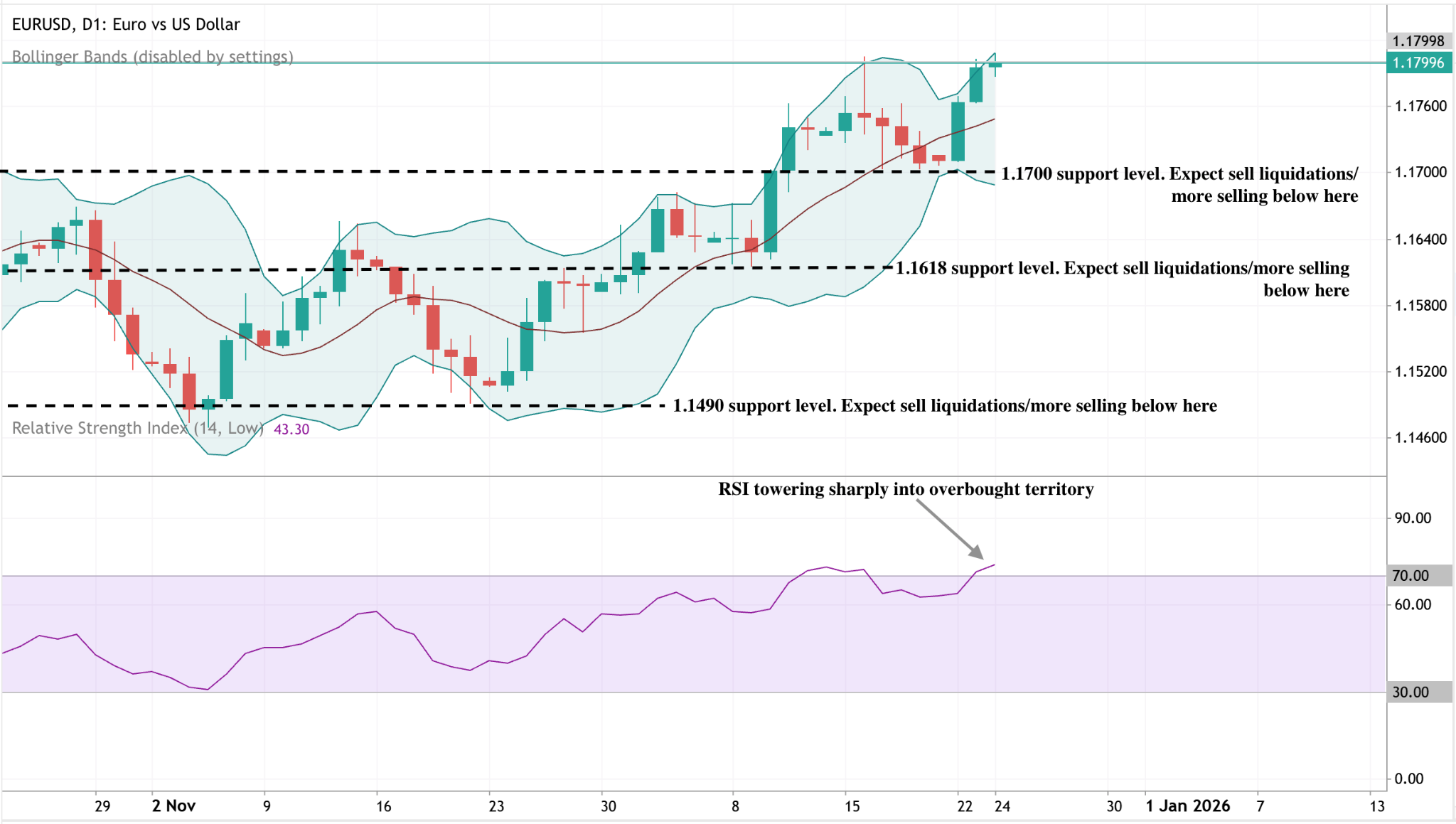
%20(1).png)
Why Gold is surging again: Can the rally last?
Gold surges again as investors reposition for rising geopolitical risk and shifting monetary policy expectations.
Gold is surging again; market data suggests investors are repositioning for a world defined by rising geopolitical risk and shifting monetary policy expectations. Spot prices have climbed back to record highs, surpassing $4,460 per ounce, and lifting year-to-date gains to around 70%, as markets respond to US actions against Venezuelan oil shipments and renewed uncertainty across global energy trade routes.
At the same time, analysts report that the outlook for US interest rates has turned decisively more supportive. With real yields falling to their lowest levels since mid-2022 and futures markets pricing in multiple Federal Reserve rate cuts next year, the opportunity cost of holding non-yielding assets has dropped sharply. The question now is whether these forces are powerful enough to sustain the rally or whether gold is nearing a turning point.
What’s driving gold?
The immediate catalyst behind gold’s latest surge is a rise in geopolitical tension centred on Venezuela. The US Coast Guard recently seized a sanctioned supertanker carrying Venezuelan oil and attempted to intercept two additional vessels, one of which was reportedly bound for China. These actions have raised concerns about broader energy-market disruptions, even as Venezuela’s reduced output limits direct supply risks.
Market sensitivity to geopolitical shocks remains high, particularly when they involve strategic commodities and major trading partners. President Donald Trump’s declaration of a naval “blockade” targeting sanctioned tankers has reinforced uncertainty rather than delivered clarity. History shows that gold responds less to the scale of economic damage and more to the unpredictability such confrontations introduce into global markets.
Monetary conditions have added a second, equally important layer of support. US real interest rates - a key driver of gold demand - have slipped to levels last seen more than three years ago.
According to futures pricing, traders continue to expect at least two Federal Reserve rate cuts in 2026, following signs of labour-market cooling and easing inflation pressures. As yields fall, gold’s relative appeal increases, particularly for institutional investors seeking stability and diversification.
Why it matters
Gold’s rally matters because it reflects a broader reassessment of risk rather than a short-lived flight to safety. The metal has not only recovered from its late-October pullback but has reasserted itself as one of the strongest-performing assets of the year. UBS strategists note that bullion is now consolidating gains at record levels after a sharp advance, reinforcing its status as a core defensive holding.
This performance signals what many analysts interpret as deeper concerns about financial resilience. Persistent geopolitical flashpoints, uncertainty surrounding US monetary leadership, and growing skepticism towards long-term debt sustainability have prompted investors to shift towards assets perceived as politically neutral. Gold’s liquidity, global acceptance, and history as a store of value place it in a unique position when confidence in fiat systems begins to fray.
Impact on markets and investors
Institutional and central bank demand is reshaping the structure of the gold market. UBS estimates that central banks will purchase between 900 and 950 metric tonnes of gold this year, close to record levels. This steady accumulation has reduced downside volatility and helped establish a new price floor well above $4,300 per ounce.
Currency dynamics have further reinforced the trend. The US dollar has slipped towards one-week lows against major peers, making dollar-priced bullion more affordable for overseas buyers. For investors outside the US, gold has served as both a hedge against currency weakness and protection against rising geopolitical uncertainty.
Silver’s parallel surge adds another dimension. Prices have climbed close to $70 per ounce after gaining roughly 140% this year, far outpacing gold. When both metals rally together, it often points to broad-based risk aversion combined with speculative participation, rather than a narrow defensive trade.
Expert outlook
Looking ahead, analysts broadly expect gold to consolidate rather than reverse sharply. UBS argues that prices are digesting gains after an aggressive move higher, supported by falling real yields and sustained institutional demand. The bank also highlights that gold has benefited from the US real interest rate dropping to its lowest level since mid-2022, reducing the opportunity cost of holding bullion.
There are, however, risks to monitor. Any sudden de-escalation in geopolitical tensions or a resurgence in real yields could prompt short-term corrections. Even so, portfolio managers increasingly view pullbacks as opportunities rather than warning signs. With some forecasts pointing towards $5,000 per ounce in 2026, gold’s role as both a hedge and a strategic asset appears firmly re-established.
Key takeaway
Gold’s renewed surge appears to be driven by a rare convergence of geopolitical risk, falling real yields, and persistent institutional demand. Analysts suggest that the rally reflects strategic repositioning rather than fear-based buying. With central banks still accumulating and rate cuts firmly on the horizon, gold’s role in portfolios is evolving. Investors will be watching inflation data, Federal Reserve signals, and geopolitical developments for the next decisive catalyst.
Gold technical insights
Gold remains firmly bullish, with price breaking higher and pushing along the upper Bollinger Band, signalling strong upside momentum and increasingly FOMO-driven buying. The sharp expansion of the bands highlights rising volatility in favour of the bulls.
On the downside, $4,365 now serves as near-term resistance and a reaction zone, while $4,035 and $3,935 remain the key supports. A break below these levels would likely trigger sell-side liquidations, but for now, dips continue to attract buyers. Momentum is stretched, with the RSI rising sharply deeper into overbought territory, increasing the risk of a pause or shallow pullback.
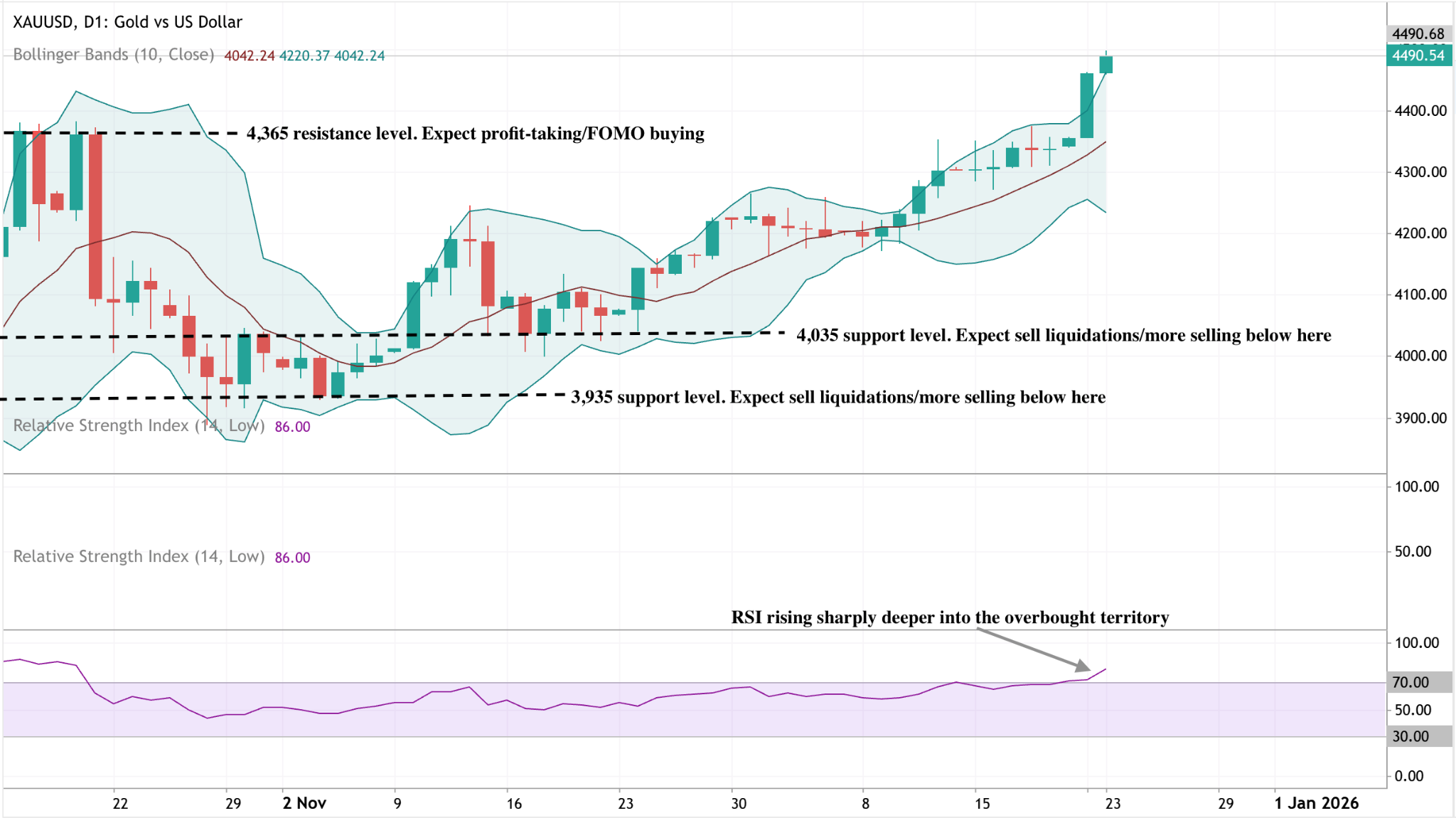
%20(1)%20(1).png)
Bitcoin slips below $90K as demand signals turn bearish
Bitcoin drops 22% in Q4. Data shows it is facing its worst year-end performance outside of major bear markets.
Bitcoin’s struggle to hold above $90,000 is no longer just a question of volatility. After falling more than 22% in the fourth quarter, the world’s largest cryptocurrency is on course for its weakest year-end performance outside of major bear markets, according to CoinGlass data.
Repeated rebounds have failed to gain traction, with price gains from Asian and European sessions fading once US markets open. Observers note that loss of momentum matters because it reflects more than short-term positioning. A mix of derivatives pressure, cooling institutional demand, and weakening on-chain signals suggests Bitcoin may be entering a new phase of fatigue.
As record options expiries approach and demand indicators deteriorate, traders are being forced to reassess whether this is a consolidation or the early stages of a deeper downtrend.
What’s driving Bitcoin’s latest weakness?
Bitcoin’s recent slide below $88,000 during the US trading session reflects growing pressure from derivatives markets rather than sudden panic selling.
Bitcoin’s weak year-end

Price action has become increasingly erratic between $85,000 and $90,000 as traders position ahead of a record $28.5 billion in Bitcoin and Ethereum options expiring on Deribit. That figure represents more than half of the exchange’s total open interest, amplifying sensitivity around key strike levels.
At the centre of that tension sits Bitcoin’s $96,000 “max pain” level, where option sellers benefit most, according to Deribit’s chief commercial officer Jean-David Pequignot. A heavy $1.2 billion cluster of put options at $85,000 adds downside gravitational pull if selling accelerates. While longer-dated call spreads still target $100,000 and above, short-term hedging costs have risen sharply, signalling defensive rather than speculative positioning.
Why it matters
This shift is significant because Bitcoin’s recent rally phases were driven by demand expansion, rather than mechanical supply events. On-chain data from CryptoQuant indicates that demand growth has been slipping below its long-term trend since early October, marking a transition from expansion to contraction.
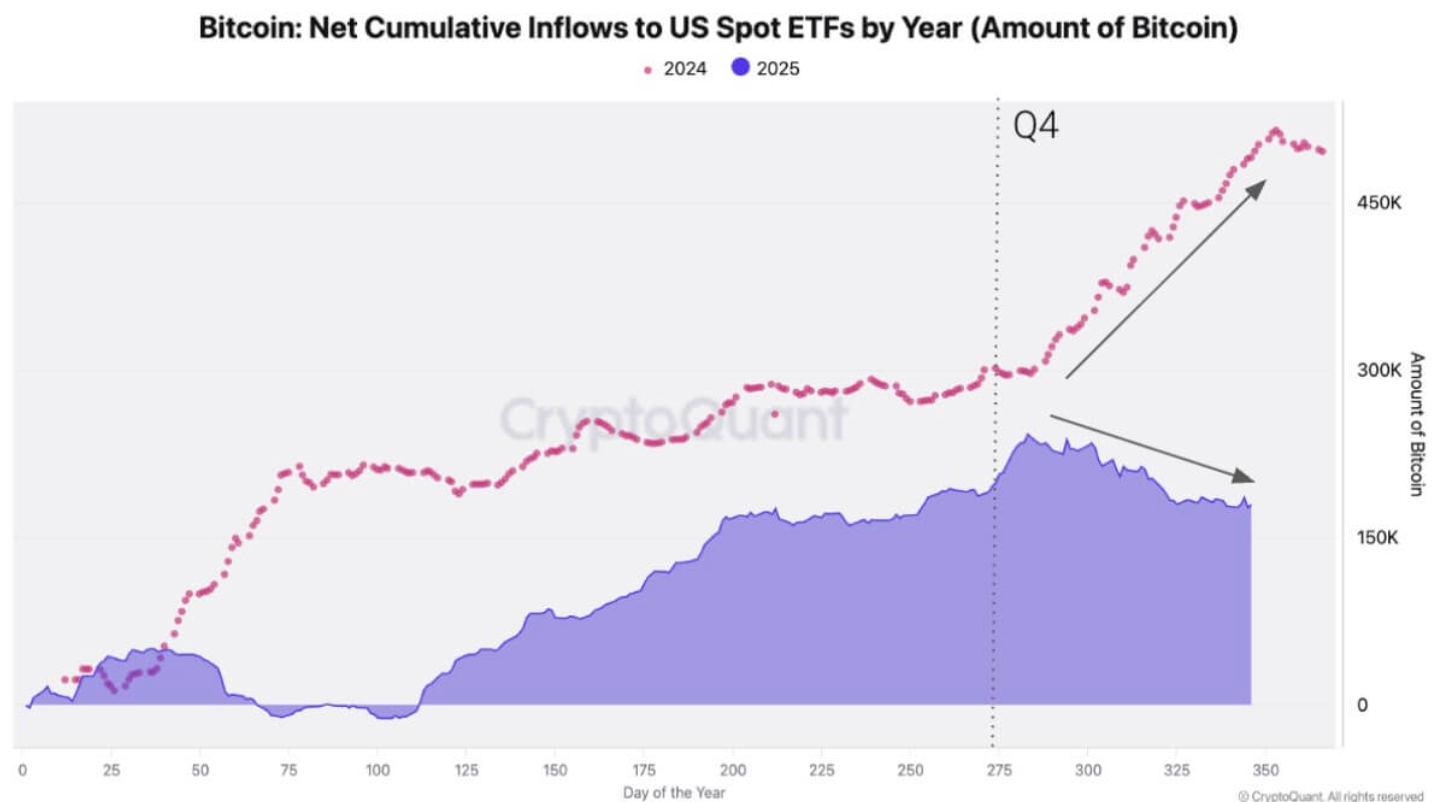
Historically, that pattern has coincided with major cycle inflection points rather than temporary pullbacks. Alex Kuptsikevich, chief market analyst at FxPro, describes the current rebound attempts as technical rather than structural. He argues that recent strength reflects exhaustion after weeks of selling, not renewed conviction.
Sentiment indicators support that view, with the crypto Fear and Greed Index rising to 24 but remaining firmly in pessimistic territory.

Impact on the crypto market and traders
Market data shows that Bitcoin’s hesitation has rippled across the broader crypto market, keeping major tokens range-bound despite brief rallies. Ether, Solana, XRP, Cardano and Dogecoin have posted modest gains, yet none have broken decisively higher.
The total crypto market capitalisation has reclaimed the $3 trillion mark, a level that has served as a battleground between buyers and sellers throughout the past month.
Beneath the surface, cracks are visible. According to market data, US spot Bitcoin ETFs have shifted from aggressive accumulation to net selling, with holdings declining by roughly 24,000 BTC in late 2025. At the same time, long-term funding rates in perpetual futures have fallen to their lowest levels since late 2023, signalling waning appetite for leveraged long exposure.
Expert outlook: Consolidation or downtrend?
CryptoQuant analysts warn that Bitcoin may already be in a new downtrend, driven by demand exhaustion rather than macro shocks. The catalysts that powered the last expansion - spot ETF approvals, the US election outcome, and corporate treasury adoption - have largely been absorbed. Without fresh demand, price support has weakened, leaving Bitcoin vulnerable to deeper pullbacks.
That does not eliminate the possibility of recovery. CryptoQuant notes that Bitcoin cycles hinge on demand regeneration, not time-based events like halvings. If institutional flows stabilise and on-chain activity improves, a recovery later in 2026 remains plausible. Until then, the market faces a tug-of-war between six-figure forecasts and downside scenarios that place support closer to $70,000.
Key takeaway
Bitcoin’s inability to reclaim $90,000 reflects deeper structural fatigue rather than short-term volatility. Cooling institutional flows, defensive derivatives positioning, and weakening on-chain demand suggest the market has entered a more cautious phase. While long-term optimism has not vanished, near-term risks remain skewed to the downside. Traders will be watching options expiry dynamics, ETF flows, and demand indicators closely for signs of a genuine trend shift.
Bitcoin technical insights
Bitcoin remains range-bound, with price capped below the $94,600 resistance level and trading near the middle-to-lower Bollinger Band, signalling weak upside momentum and a lack of strong buyer conviction. Previous attempts to reclaim higher levels have waned, maintaining the broader structure's corrective nature.
On the downside, $84,700 remains a critical support level, with a clean break likely to trigger sell-side liquidations. Momentum is softening, with the RSI dipping just below the midline, suggesting bearish pressure is gradually building rather than aggressively accelerating.

.png)
Santa Claus rally 2025: Will the stock market get a gift?
It is December 2025. The Fed has just cut interest rates for the third time, but the S&P 500 is stumbling. Traders are asking one question: Is the holiday party cancelled?
It is December 2025. The Fed has just cut interest rates for the third time, but the S&P 500 is stumbling. Traders are asking one question: Is the holiday party cancelled?
Every year around this time, Wall Street turns its attention to one of the market’s most festive - and oddly persistent - seasonal patterns: the Santa Claus rally. It’s a short window, steeped in market folklore, that has a habit of stirring optimism just as liquidity thins and investors close the books on the year.
But with economic data softening and equity leadership narrowing, Santa’s arrival this year feels less certain.
What is the Santa Claus rally?
The Santa Claus rally refers to a seven-trading-day period covering the final five trading days of December and the first two trading days of January. According to the Stock Trader’s Almanack, this window has delivered an average gain of around 1.2–1.3% for the S&P 500 since 1950 - a stronger return than the average for most months of the year.
The pattern was first identified in 1972 by Yale Hirsch, founder of the Almanac, and has since become a closely watched seasonal tendency rather than a guaranteed outcome.
In 2025, the Santa Claus rally window runs from Wednesday, 24 December, through Monday, 5 January.
Why markets often rally at year-end
There’s no single reason behind the Santa Claus rally, but several forces tend to align at the same time:
- Holiday optimism improves investor sentiment
- Year-end bonuses flow into financial markets
- Tax-loss selling fades, reducing downward pressure
- Institutional investors step back, leaving lighter volumes
- Expectations reinforce behaviour, creating a self-fulfilling effect
With thinner liquidity, even modest buying can have a disproportionately large impact - particularly in major indices.
When Santa doesn’t show, bears sometimes do
The Santa Claus rally carries an outsized reputation because of what it’s thought to signal when it fails.
An old Wall Street saying warns:
“If Santa Claus should fail to call, bears may come to Broad and Wall.”
History suggests the relationship is far from perfect. Since 1969, there have been 14 years when the S&P 500 delivered negative returns during the Santa window. In those cases, the market finished the following year lower only four times, making the indicator more of a sentiment gauge than a forecasting tool.
Still, the rally itself has shown up around 76% of the time since 2000, far better odds than a random seven-day trading period.

This year’s backdrop is unusually mixed.
On one hand, US jobs data has softened, hinting that economic momentum may be slowing. Market gains remain heavily concentrated in a handful of mega-cap stocks, increasing the risk of sharper pullbacks if sentiment shifts.
On the other hand, the Federal Reserve is firmly in easing mode.
With three rate cuts already delivered and futures markets pricing in at least two more in 2026, financial conditions are becoming increasingly loose. History shows that betting against the Fed is rarely a winning strategy, particularly during periods of low liquidity, such as year-end.
That monetary tailwind could be enough to support a late-year lift - even if confidence remains fragile.
Santa is festive, not flawless
Seasonality is helpful, but it isn’t destiny.
The Santa Claus rally failed to materialise in 2023 and 2024, and last year the S&P 500 slipped during the festive window. In contrast, from 2016 to 2022, the market experienced growth every year, with gains exceeding 1% in several instances.
Even in years when the broader market finished lower, the Santa window often still delivered gains. In down years since 1969, the median Santa rally return was roughly 1.3%, despite double-digit declines over the full year.
In short, Santa may be unreliable - but historically, he’s turned up more often than not.
One asset to watch: Gold
While the Santa Claus rally traditionally focuses on equities, gold may be the more interesting asset to watch this year. According to analysts, rate cuts tend to compress real yields and soften the US dollar, two conditions that have historically supported gold prices. With the Fed easing and inflation risks still lingering beneath the surface, the macro backdrop is quietly becoming more favourable for the yellow metal.
From a technical perspective, gold has shown resilience rather than weakness. Prices have held above key medium-term support levels despite equity volatility, suggesting that dips continue to attract buyers rather than trigger panic selling.
If risk sentiment improves into year-end, gold could grind higher alongside equities. If equities falter or volatility spikes, gold may benefit from defensive flows instead. Either way, it provides traders with a means to express the same macro view without relying solely on stock market direction.
So is Wall Street getting a gift or the Grinch?
That remains the question.
The Santa Claus rally is not a crystal ball, and it won’t erase concerns around slowing growth, valuation, or market concentration. But history suggests that dismissing it entirely has often been costly.
With the Fed easing, liquidity thinning, and sentiment delicately balanced, analysts expressed the odds still lean towards a late-year move - even if it proves short-lived. Whether Wall Street unwraps a gift or gets a lump of coal, Santa’s window is open - and the market is watching closely.
Expert outlook: Why gold may steal Santa’s spotlight
While equity investors debate whether Santa shows up, gold may not need the invitation. Easing monetary policy, softer real yields, and ongoing macro uncertainty create a backdrop where gold can perform regardless of whether equities rally or retreat. Year-end liquidity conditions may further amplify market movements, particularly if US dollar volatility increases.
For traders, the focus remains on:
- Key support zones near recent breakouts
- RSI holding above neutral, signalling trend stability
- US dollar direction during thin holiday trading
- Gold doesn’t rely on festive optimism - it thrives on uncertainty.
Key takeaway
The Santa Claus rally is a seasonal tendency, not a promise. This year, its fate rests on the balance between easing monetary policy and fragile market confidence. Market watchers highlighted that if equities rally, it could reinforce bullish momentum into early January. If they don’t, assets like gold may take centre stage as investors turn defensive. Either way, year-end is shaping up to be less about blind optimism and more about positioning, selectivity, and risk management.
Gold technical insights
Gold remains in a strong bullish trend, with price trading near the upper Bollinger Band, signalling sustained upside momentum but also increasing the risk of short-term consolidation. The steady expansion of the bands suggests volatility remains supportive of the broader uptrend.
On the downside, $4,035 is the first key support, followed by $3,935, where a break could trigger sell-side liquidations and a deeper corrective move. Momentum remains elevated, with the RSI rising into overbought territory, indicating strength but also warning that upside gains may slow without a pullback.

%20(1)%20(1)%20(1)%20(1)%20(1)%20(1)%20(1)%20(1).png)
An ounce of silver now costs more than a barrel of oil
On Dec 22, 2025, silver (~$68/oz) officially surpassed WTI crude oil (~$57/bbl), marking a rare event in commodity markets.
On 22 December 2025, a remarkable event occurred in global commodity markets: an ounce of silver traded at approximately $67-68 per troy ounce, surpassing the price of a barrel of West Texas Intermediate (WTI) crude oil, which was hovering around $56-57, according to reports.
Brent crude, the international benchmark, was slightly higher at about $60-61, but the core message remained the same-one ounce of the white metal was worth more than 42 gallons of black gold.
This inversion hasn’t occurred in over four decades, with the last comparable episode tracing back to the volatile commodity boom of the late 1970s and early 1980s. Back then, a speculative frenzy briefly pushed silver prices high enough to surpass those of oil. Today, the crossover, first achieved earlier in 2025 when silver broke $54 while oil lingered in the $65-75 range, feels more structural than speculative. Analysts are calling it a "defining moment" for 2025, reflecting profound changes in how the world values energy and materials.
What’s fueling silver’s explosive rally
Silver has delivered one of its most dramatic years on record, surging roughly 127-130% year-to-date to all-time highs above $67, based on data. This outpaces gold's strong ~60-65% gain, underscoring silver's unique dual role as both a monetary hedge and an industrial powerhouse.
The rally is rooted in tight physical supply and exploding demand. Reports showed that global silver mine production has stagnated, while recycling can't bridge the gap, leading to persistent market deficits-projected at 95–149 million ounces for 2025 alone, marking a fifth straight year of shortfalls. Cumulative deficits since 2021 now exceed 800 million ounces, draining inventories to multi-decade lows.
Industrial consumption, which accounts for over 60% of demand, is the real accelerator. Silver's unmatched electrical conductivity makes it irreplaceable in green technologies:
- Solar energy: Photovoltaic panels consumed over 200 million ounces in recent years, with demand up sharply as global installations boom. Each panel uses 15-25 grams of silver, and ambitious targets (e.g., EU's 700 GW by 2030) promise sustained growth.
- Electric vehicles (EVs): A typical EV requires 25-50 grams of silver-double that of traditional cars—for batteries, electronics, and charging infrastructure. Automotive demand is forecast to grow at 3-4% annually through 2031.
- Electronics and AI: Data centers, 5G networks, and semiconductors add further pull, with AI-driven power needs amplifying usage.
In other reports, macro tailwinds have amplified the move: Federal Reserve rate-cut expectations (pricing in further easing amid cooling inflation and rising unemployment to 4.6%), a weaker U.S. dollar (down ~8–9% YTD), and safe-haven flows amid geopolitical uncertainty. Silver's addition to the U.S. critical minerals list has drawn institutional interest, viewing it as a strategic play on the energy transition.
Why oil is struggling to keep up
In stark contrast, crude oil has had a brutal 2025, with WTI down 18-20% YTD-on track for its worst annual performance since the 2020 pandemic crash. Prices dipped to near five-year lows before modest rebounds on events like U.S. sanctions on Venezuelan tankers.
The culprit? Chronic oversupply, according to experts. Non-OPEC+ producers (led by U.S. shale at a record of ~13.5–13.8 million bpd, with growth also from Brazil and Guyana) have flooded the market. OPEC+ has gradually unwound its voluntary cuts, adding hundreds of thousands of barrels daily, while global inventories are building aggressively. Crude oil inventories have risen sharply since the summer.
Demand growth has disappointed, particularly in China (despite stockpiling) and softening in Europe/U.S. amid efficiency gains and slower economic momentum. Forecasts indicate that surpluses will persist into 2026, with Brent potentially averaging $55 or lower if inventories continue to rise.
Geopolitical flare-ups provide brief lifts, but they’ve failed to reverse the downtrend in a well-supplied world.
Why this inversion matters: A window into global shifts
This silver-over-oil moment isn’t just a quirky headline - it’s a barometer for deeper transformations.
It highlights the energy transition in action: Markets are rewarding commodities tied to decarbonization (solar, EVs, renewables) while discounting legacy fossil fuels. Silver, dubbed the "new energy metal," embodies the rise of green technology, while oil grapples with peak demand narratives and abundant supply.
According to experts, the sharply compressing gold-silver ratio (down to ~70:1 from over 100:1) indicates that traders are banking on silver's industrial upside, alongside its monetary appeal, in an era of easing policy and inflation vigilance.
Historically, such extremes echo the spikes of the 1970s and 1980s, when inflation and commodity booms drove wild swings. Today’s rally feels more fundamentals-driven, but history warns of volatility - parabolic moves often precede sharp corrections.
For investors, this flips the script on commodities: What was once the "king" (oil) now lags a metal long seen as secondary. Portfolios tilted toward transition themes may benefit, but risks remain-economic slowdowns could crimp industrial demand, while OPEC+ discipline (or lack thereof) could swing oil prices.
Looking ahead: Boom, bust, or new normal?
Silver’s trajectory points higher if deficits persist and green demand accelerates-some analysts eye $70–$75 by late 2026. Yet overbought technicals and holiday-thin liquidity invite pullbacks.
Oil prices could stabilise if OPEC+ reins in output or demand surprises to the upside, but oversupply forecasts suggest prolonged pressure. Ultimately, 22 December 2025, marks more than a price crossover; it's a signal that the global economy is rewiring itself around sustainability, technology, and resilience. In this new era, an ounce of silver might just shine brighter than a barrel of oil for years to come.
Technical insights
Silver remains firmly bullish, with price hugging the upper Bollinger Band, signalling strong upside momentum but also stretched conditions. The steep slope of the bands highlights persistent buying pressure, though near-term consolidation cannot be ruled out.
On the downside, $57.00 is the first key support, followed by $50.00 and $46.93. A break below these levels would likely trigger sell-side liquidations and a deeper corrective move. Momentum remains elevated, with the RSI flat well into overbought territory, reinforcing strength but warning that upside gains may slow without a reset.

US oil remains under near-term pressure, with price trading below the $60.00–$61.10 resistance zone and capped by the upper Bollinger Band. The broader structure still indicates a corrective phase, although the selling momentum has started to slow.
On the downside, $55.40 is the key support, where a break would likely trigger sell-side liquidations. Momentum is attempting to stabilise, with the RSI rising slowly from oversold levels towards the midline, suggesting downside momentum is easing but lacking clear bullish conviction.
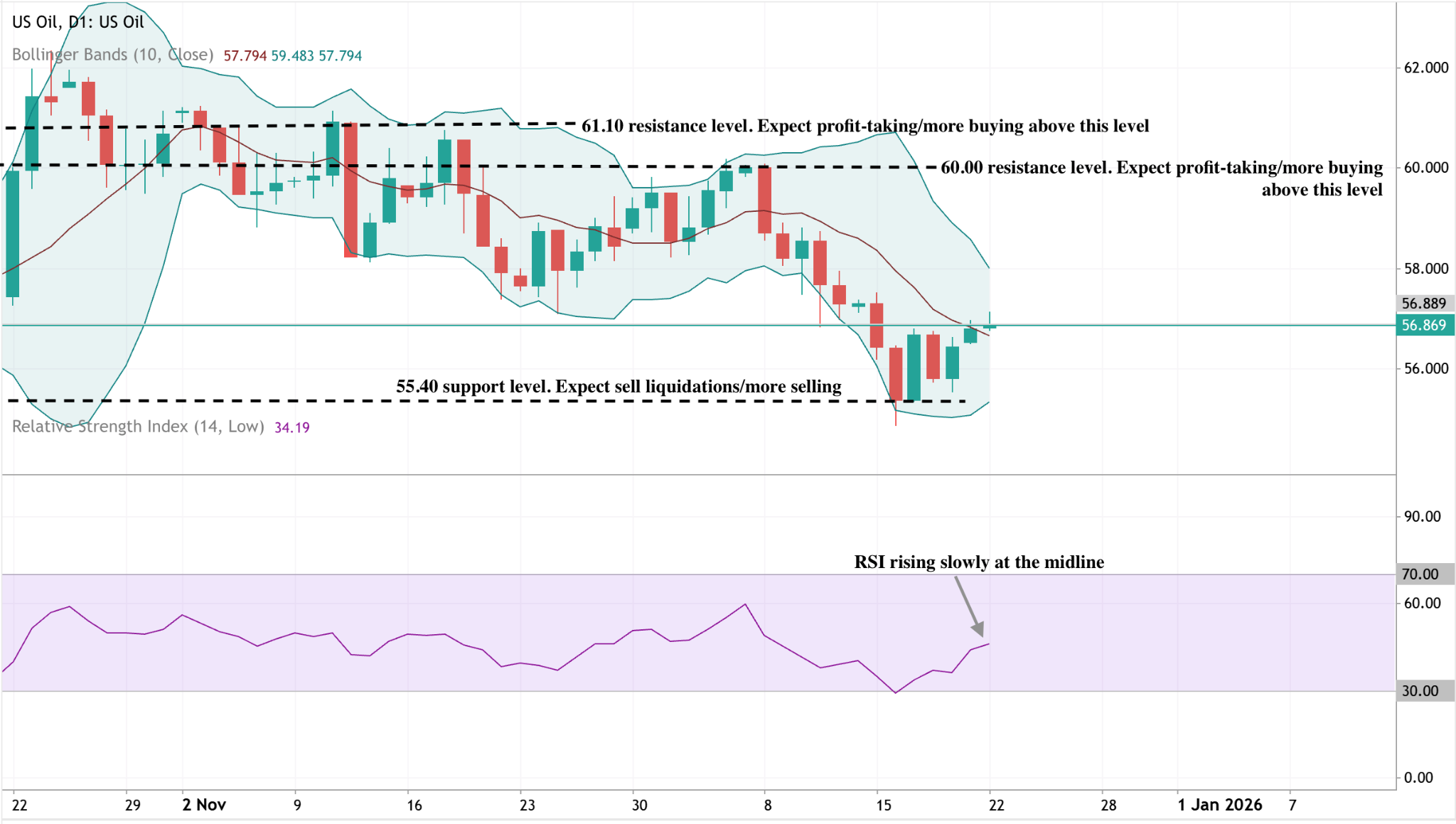
Sorry, we couldn’t find any results matching .
Search tips:
- Check your spelling and try again
- Try another keyword